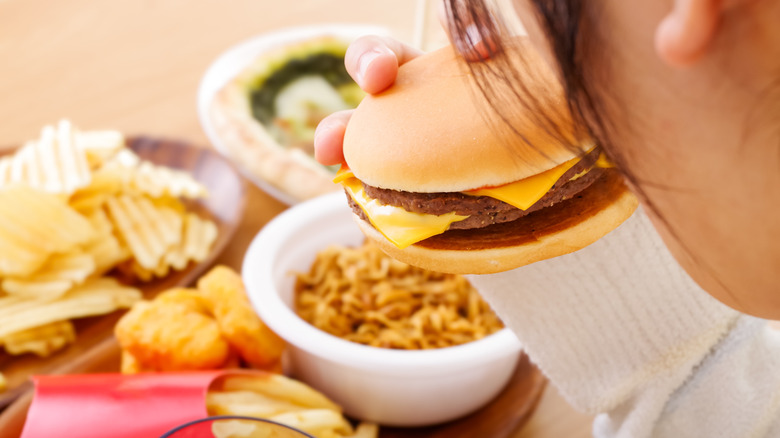This Is Why Experts Say Fast Food Is Ultra-Processed
When you're grabbing fast food, convenience is the name of the game. We want a tasty, quick meal, so how processed the food is may not be top of mind. For some expert insight on what constitutes ultra-processing in food — and why fast food falls into this category — Food Republic turned to Shalvi Singh, founder of Healthengine.us and senior product manager at Amazon AI.
Singh illuminated the position fast food occupies within the NOVA classification system, which separates food into four categories based on the amount of processing it undergoes before reaching consumers, with level 1 being not processed and level 4 being most processed. "Fast food falls into group 4 in the NOVA classification system with ultra-processed foods (UPF)," Singh explained. "These include industrial formulations encompassing [five] or more, and usually many more, distinctive hyper-palatable ingredients. UPFs also make use of non-culinary kitchen substances like high-fructose corn syrup [and] hydrogenated oils ... They undergo industry-specific techniques like extrusion, molding, pre-frying, and special packaging."
Many fast-food makers cut expenses and amp up the shelf life, flavor, and texture of foods by ultra-processing them with added sweeteners, preservatives, industrial fats, emulsifiers, and stabilizers. "Fast foods with an ultra-processed label go through several industrial stages of profound processes aimed at enhancing structure [while] stripping nutrients and depleting their mineral composition," Singh shared.
Different levels of processing, and effects UPFs can have on the body
Group 4, the classification that a great deal of fast food falls under, is the highest threshold on the NOVA scale, indicating items with the most processing and alteration. By comparison, foods in groups 1 and 2 aren't significantly altered from their original forms. "[Group 1] covers unprocessed or minimally processed foods like whole fruits, yogurt, and grains — fresh or frozen food items like fruits and yogurt[,] which are only pressed, dried, ground, or pasteurized without any added salts, sugars, or oils," Shalvi Singh clarified. "[Group 2] includes culinary ingredients like olive oil, vinegar, or butter[,] which are directly derived from Group 1 foods. These generally have one to three ingredients, without industrial additives, retaining fiber, micronutrients, and the intact food matrix."
Some ultra-processed foods retain more nutrients than others. Items like yogurts and wheat breads can fall into the ultra-processed category, for instance, but they still offer nutritional value.
Ultra-processed foods, by and large, are pleasing to the palate. Many UPFs are high in sugar and fat, triggering pleasure responses in the brain, which prompts consumers to increase their intake of such items. A 2021 documentary released by the BBC found that eating a diet primarily composed of ultra-processed foods over an extended period of time actually created new connections in the reward center of the brain (an area which impacts decision making), similar to those that would show up in the brain scans of someone using addictive substances. A 2019 randomized controlled trial sponsored by the National Institute of Diabetes and Digestive and Kidney Diseases (NIDDK) found that diets replete with ultra-processed foods led to increased calorie consumption and resultant weight gain.
Quick-bite alternatives to ultra-processed fast foods
While a great deal of quick-dining fare contains UPFs, not all fast food is high in ultra-processed ingredients. If you're heading out for a fast-food hamburger, for instance, a quick perusal of a restaurant's nutrition guide can often help you determine how processed the food is. You can also ask servers about the ingredients and cooking processes used at a particular dining spot.
"[Separated] meat is combined with binders and coatings before being extruded, formed, pre-fried, frozen, and reheated under heat lamps — procedures intended for efficiency and standardization rather than nutrient preservation," Shalvi Singh shared. "Each action, such as deep frying in reused oil or going through multiple freeze-thaw cycles, can destroy vitamins, oxidize fats, and increase the glycemic load by converting complex carbohydrates into simpler, rapidly absorbable sugars."
But some restaurant chains use 100% pure beef in their burgers, rather than ultra-processed patties, including Wendy's, Five Guys, and In-N-Out Burger. So, a trip to these drive-thrus will deliver a less-processed hamburger. Sammies at In-N-Out Burger and Five Guys also rank among the best fast-food burgers, according to Reddit users.
Some of these same fast-food chains are also known for serving up french fries that are lower on the processing scale. Five Guys' fries are made from potatoes that are freshly cut in-house, not pre-processed. The french fries at In-N-Out Burger are similarly hand-cut onsite from raw potatoes. You can also make some easy swaps at the menu board, as many quick-bite restaurants offer salads, fruit, and similar alternatives that undergo less processing.



